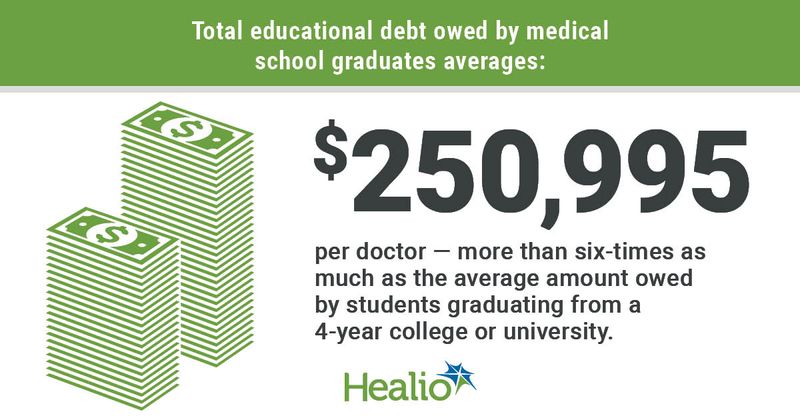Student loan repayment presents challenges, strategies for physicians
The end of the federal student loan payment pause, a reprieve that lasted more than 3 years due to the COVID-19 pandemic, marks a critical juncture for millions of Americans, especially for physicians.
Doctors of all specialties often start their careers under the weight of substantial student loan debt, a result of extensive and expensive medical training. This article explores the multi-faceted challenges physicians face in this new phase of loan repayment, offers strategies to manage this debt effectively and covers the importance of simultaneous investment for retirement and future financial stability.

Burden of student loan debt
Student loan debt has increasingly become a defining aspect of a medical professional’s early career. Upon completion of their education, physicians often find themselves saddled with an enormous financial burden. Data from the Education Data Initiative reveals that the total educational debt owed by medical school graduates averages $250,995 per doctor — more than six-times as much as the average amount owed by students graduating from a 4-year college or university. As of 2018, the cost of medical school in the U.S. was increasing at an annual rate of 2.5%, while the amount of medical school debt was increasing at a rate of 12.4% each year. If educational debt for physicians continues to outpace the cost of medical school at the present rate, the average medical student debt will exceed $300,000 in 2024. With this data in mind, it is no surprise that 45.2% of medical school students cite their ability to pay off debt as a primary concern.

This significant level of debt can profoundly impact the physician’s credit, savings and retirement planning. The interest accumulated during medical school and residency can significantly inflate this amount, hindering financial freedom for years. This burden is exacerbated by the lengthy nature of medical education, which delays the commencement of full-time earning for years compared to other professions. Medical student loan costs can balloon the highest during residency and fellowship due to capitalization, a process where unpaid interest is added to the principal balance of the loan, increasing the overall debt.
Impact of the payment pause
The 3-year student loan payment pause, initiated in March 2020, provided significant relief to borrowers, including medical students and physicians. This administrative forbearance suspended loan repayments and offered borrowers a 0% interest rate, effectively freezing the debt growth during this period. While this was a welcome development for many, it was a temporary solution to a long-term problem. For young physicians, this pause offered a breather in their financial journey, allowing some to temporarily redirect funds to other financial goals or obligations.


The student loan payment hiatus ended in 2023, with the resumption of interest accrual in September and required payments in October. For many recent medical school graduates and practicing physicians, the reality of this debt has re-emerged as a pressing concern. The transition back to regular payments is not just a logistical change but also a psychological and financial adjustment. Physicians must now revisit their repayment strategies, considering their current income levels, loan amounts and the interest rates that are now in effect.
Repayment strategies
Effective repayment strategies are essential in managing student loan debt. Options like income-driven repayment plans, loan consolidation and refinancing can provide some relief. The Biden administration’s Saving on a Valuable Education (SAVE) plan, which replaced The Revised Pay As You Earn (REPAYE) program in 2023, is designed to make payments more manageable based on income levels. For physicians, particularly those in the early stages of their careers or those with variable income levels, this plan can offer a more feasible pathway to debt management.
One of the simplest methods for reducing the burden of student loan debt is refinancing the loan(s) through a private lender when starting practice. Refinancing is a relatively easy way to not only consolidate your student loans into one lump sum, but also lower your interest rate considerably. Although you may give up certain loan protections inherent to federal student loans and income-based repayment models, the upside of refinancing is typically a significant reduction in student loan interest rate, which can dramatically reduce the total cost of the debt over the length of the loan.
Balance loans, retirement planning
Although managing student loan debt is paramount, physicians must not neglect planning for retirement and future financial security. This dual focus is crucial for long-term financial health. Starting retirement savings early, even amid loan repayments, can leverage the power of compound interest, essential for building a substantial retirement fund.
Physicians may consider options like employer-sponsored retirement plans, IRAs and investment in stocks or mutual funds as potential tools to build wealth for retirement. Seeking professional financial advice can be beneficial in creating a balanced approach that addresses both debt repayment and future financial goals. This approach ensures that current debts are addressed while actively building financial security for the future.
Conclusion
As student loan payments resume, physicians face the complex task of managing substantial debt while also investing in their future. The end of the payment pause is not just a call to resume payments but an opportunity to reassess and realign financial strategies.
Effective debt management, coupled with strategic investments in retirement and future planning, will be key to achieving long-term financial stability and success. As the landscape of student loan repayments continues to evolve, staying informed and proactive in financial planning is essential for physicians to navigate this challenging but manageable journey.
References:
Wealth Planning for the Modern Physician and Wealth Management Made Simple are available free in print or by ebook download by texting HEALIO to 844-418-1212 or at www.ojmbookstore.com. Enter code HEALIO at checkout.
For more information:
Sanjeev Bhatia, MD, is an orthopedic sports medicine surgeon practicing at Northwestern Medicine in Warrenville, IL. He can be reached at sanjeevbhatia1@gmail.com or @DrBhatiaOrtho. David B. Mandell, JD, MBA, is an attorney and founder of the wealth management firm OJM Group www.ojmgroup.com, where Jason M. O’Dell, MS, CWM, is a partner and tax consultant. They can be reached at 877-656-4362 or mandell@ojmgroup.com.

